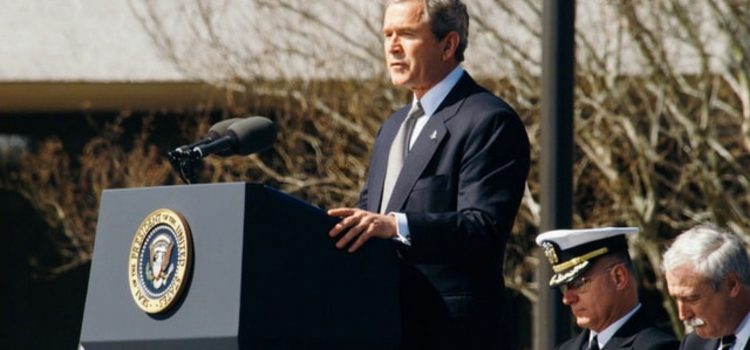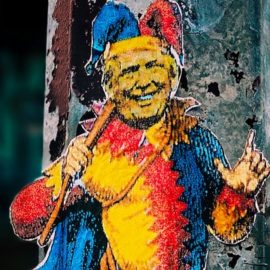

This article is an excerpt from the Shortform book guide to "The Shock Doctrine" by Naomi Klein. Shortform has the world's best summaries and analyses of books you should be reading.
Like this article? Sign up for a free trial here .
What is Shock and Awe? What was the reason the United States invaded Iraq in 2003?
The term “Shock and Awe” is typically used to refer to the 2003 United States invasion of Iraq under George Bush’s administration. Bush sold the project to Americans with a simple promise that they were bringing freedom to a troubled area. Many mistook this for a promise of free and fair democracy. However, the real objective was to create the freedom for private companies to harvest as much of the country’s wealth and resources as possible.
In this article, we’ll discuss the real motives behind Iraq’s Shock and Awe war and what happened it its aftermath.
The Model Theory
Free market proponents claimed that a restructured Iraq would serve as a model for the rest of the Middle East, and inspire those other countries to adopt unrestricted capitalism. In other words, they promised that a brief upheaval in Iraq would directly lead to peace and prosperity across the entire Middle East. That idea was called, appropriately enough, the Model Theory.
The Model Theory was based on the premise that the Middle East was a breeding ground for terrorism, which a few cherry-picked facts seemed to support:
- The 9/11 attackers were from Saudi Arabia and other Middle Eastern nations.
- Hezbollah got funding from Iran.
- Hamas’s leadership was based in Syria.
- Iraq sent money to support the families of suicide bombers.
Those who favored the Model Theory refused to consider that the apparent rash of terrorism might be backlash against American and Israeli meddling in those countries, so they offered another explanation: the region’s lack of free-market capitalism and democracy. Therefore, they sought to end terrorism by tearing down the Iraqi government and economy, then rebuilding it according to Chicago School principles.
By the logic of the Model Theory, three objectives were bundled together into one project:
- Fighting against terrorism
- Spreading capitalism to the Middle East, the last major region in the world that the Chicago School’s crusade hadn’t reached yet
- Establishing democracy after the fact—which is to say, using post hoc elections to lock in the changes
From Military Shock to Economic Shock
The invasion and occupation of Iraq marked a brutal return to the earliest strategies of the free-market vendetta—using shock and awe to wipe out any resistance to fundamentalist capitalism. However, the War on Terror went even farther and faster than any previous efforts. It was as though strategists and economic experts reviewed the available shock tactics and decided to just use them all.
The operation began with sudden, overwhelming military force. In the weeks between March 20 and May 2, the US military bombarded Iraq with over 30,000 bombs—for context, that was 2/3 of the bombs ever made up to that point.
It was massive overkill from a military perspective, but the point wasn’t just to defeat the Iraqi armed forces. The Shock and Awe strategy was designed with spectacle and messaging in mind; it would fire up Americans watching it on the news, and terrify the Iraqis—and any other potential enemies watching the display—into submission.
However, the threat of force was, in many ways, as effective as force itself. A tried-and-true torture technique is to simply show a prisoner the instruments of torture, and let his imagination do all the work. Months before the first bombs were dropped, American media was broadcasting promises that Iraq would experience airstrikes so sudden and destructive that Iraqi soldiers would be either unable or unwilling to even fight back—“showing the instruments,” so to speak.
Once the war started, the citizens of Baghdad were subjected to a large-scale form of sensory deprivation. The ministry of communication was one of the first targets, along with telephone exchanges and transmitters for radio and television—in short, anything that people could use to connect with the outside world. They couldn’t so much as call their relatives to make sure they were still alive. That, combined with the terror of almost constant explosions for months on end, was worse than any battle for many Iraqis.
The targeted destruction of communication was just one example of the psychological operations—psyops—that the US military engaged in during the war. The combination of brute force and psyops left Iraqis in total shock, and too terrified to resist.
Aid Money Goes to US Companies
Paul Bremer, Bush’s appointee to direct the occupation of Iraq, was only concerned with pushing through free-market reforms as quickly as possible. He did next to nothing for the Iraqi people who were suffering from the invasion and occupation. Even foreign aid money went directly to private, foreign contractors, rather than to the people it was meant to help.
Bremer arrived in a country that was still burning—literally—and ravaged by looters. There was no traffic, no electricity, no oil production, no economic activity of any kind. There weren’t even any police officers patrolling the streets.
Yet, instead of taking any sort of action to repair the damage or soothe the populace, Bremer’s solution was to subject Iraq to the fastest and harshest course of economic shock therapy ever implemented. A mere two weeks after he got to Iraq, he threw open the borders to unregulated trade: no tariffs, no taxes, no inspections.
Meanwhile, a coalition of countries provided some $73 billion for Iraq’s reconstruction. However, Bush and Bremer used that money to write massive contracts for private companies, mostly American ones. In short, tens of billions of dollars—supposedly meant to help the Iraqis recover—were being funneled directly to foreign corporations.
Indeed, the Iraqi people were barely involved in rebuilding their own country. Iraqi firms were still crippled by power outages and infrastructure damage, so they couldn’t even try to get in on the free market’s newest gold rush.
Meanwhile, Bremer and his staff were unsympathetic in the face of soaring unemployment and widespread economic hardship. A high-ranking member of Bremer’s staff was quoted as telling Iraqis that it was their own responsibility to make sure they weren’t overwhelmed by foreign businesses. According to free-market ideology, any business that couldn’t survive—regardless of the unfair circumstances—didn’t deserve to survive.
Overwhelming Force, Underwhelming Results
In spite of the improved and expanded shock tactics, the results in Iraq were disappointing to Model Theorists and free-market economists. Many analyses concluded that the invasion was successful, but the occupation and reconstruction efforts were drawn-out and costly failures.
However, what those analyses fail to realize is that the invasion and occupation were two parts of the same strategy. The plan was to wipe the Iraqi slate clean so that Western nations, spearheaded by the Bush administration, could build their “model” country. If the occupation had failed, then the entire mission had failed.
And the occupation had certainly failed. Rather than winning over Iraqis with cheap foreign goods, Western pop culture, and the vaunted efficiency of private corporations, Bremer and his people encountered violent resistance and religious extremism every step of the way. Western troops answered that resistance with increased force of their own, and the entire country got caught up in a spiral of violence. By July 2006, an estimated 655,000 Iraqis had lost their lives in the “War on Terror.”
Naturally, someone had to be blamed for the failure, and many fingers ended up pointing at the Iraqi people. For example, USA Today published an article by former US Army officer Ralph Peters about the ongoing violence. Peters insisted that the continued resistance not only proved that the Iraqi government was incompetent, but also that Arab people as a whole were completely incapable of progress. Peters’s article was particularly harsh, but many Westerners agreed that the Iraqis were to blame.
Ideological Backlash
Despite the best efforts of Ralph Peters and many others like him, it’s impossible to separate the ever-increasing violence and extremism in Iraq from the foreign presence there. While there certainly had been extremist forces present in the country before, they only had a fraction of the influence that they’d gain in the following years.
Two polls illustrate this quite clearly: One poll, taken in February 2004, had 21% of respondents say that they favored an Islamic state. In another poll, taken just six months later, that number had rocketed up to 70%.
The key mistake that Bush and Bremer had made was, essentially, not taking the Iraqi people into account. After all, the Shock and Awe campaign was supposed to have left the people all but catatonic. Instead, every policy that Bremer enacted there made the people angrier and more violent. As far as the Iraqis were concerned, the new laws were just a modern version of pillaging.
Several key missteps doomed Bush’s and Bremer’s efforts to failure:
- Keeping the Iraqis away from the reconstruction efforts silenced Iraqi voices and angered the common people.
- Flooding the market with cheap foreign goods made Iraqi businessmen angry, since their shattered infrastructure couldn’t hope to compete.
- Suddenly laying off so many state employees crippled Iraq’s government—which ironically made Bremer’s job harder as well. (Further, many of the soldiers who lost their jobs went straight to the resistance, taking their weapons and skills with them.)
However, Bush and Bremer seemed to be either completely blind or completely apathetic to the problems that their anti-Marshall plan was causing. Despite mounting Iraqi anger and violence, they didn’t try to walk back or even slow down these changes—on the contrary, they did everything they could to make the new policies permanent.
First, the administration drafted an interim constitution that officially adopted Bremer’s laws. Once that was in place, the next goal was creating a permanent constitution to prevent future governments from ever undoing the changes that Bremer had made.
Many legal experts were confused by the White House’s obsession with getting Iraq a new constitution, for a couple of reasons. First of all, the country already had a perfectly workable constitution and had far bigger concerns than creating a new one. Second, writing a constitution is an extremely stressful and divisive process even for a healthy nation, let alone one in Iraq’s condition.
They were confused because they misunderstood the Bush administration’s concerns, which were economic rather than legal ones. The thought that any Iraqi government could ever undo their idealized free-market utopia was totally unacceptable to them.
In short, the Bush administration had badly miscalculated the long-term effectiveness of Shock and Awe in Iraq. Far from meekly accepting their fates, the Iraqi people were now finding ever-deeper reserves of anger and willpower to keep fighting back.
The Free Market Can’t Build a Government
In addition to Iraqi resistance, reconstruction efforts ran into another fundamental problem: The free-market techniques of the occupying forces stopped them from effectively building a government, because the free market is inherently incompatible with a government. For in spite of all their problems, Iraqi anger would most likely have subsided if the rebuilding efforts had worked. If Iraqi citizens had soon found themselves sitting in rooms lit by General Electric lights, getting treatment at state-of-the-art Parsons hospitals, and seeing their cities patrolled by DynCorp police, many of them would probably have stopped resisting.
However, Iraq’s interim government, the Coalition Provisional Authority (CPA), was so understaffed and had so few resources that it couldn’t even begin building the economy that Model Theorists dreamed of. For example, they had only three people assigned to privatizing state-owned factories; by contrast, East Germany had around 8,000 when it undertook the same task.
Ironically, this fundamental failure was due to the CPA’s own devotion to Chicago School fundamentals; after all, minimizing government spending is a cornerstone of free-market capitalism. Additionally, the CPA staffers’ hatred of all things “statist” meant that what they were trying to do—build a new state from the ground up—went directly against their beliefs.
Free market crusaders had been extremely effective at tearing down public institutions in other countries, but now they were proving all but useless at creating those systems in Iraq. The CPA was totally unwilling to oversee, regulate, or even inspect the work that foreign contractors were doing.
In 2007, after three and a half years of mismanagement and outright fraud, all of the major US contractors pulled out of the reconstruction. Their money was gone, and only a small fraction of the work had been done.
In one example of the CPA’s utter failure, the company Parsons had been given $186 million and a goal of building 142 clinics—only 6 were ever finished. In another example, Iraq’s power grid was actually producing less energy in 2007 than it had in 2006.
Michael Wolfe, a political scientist, opined that conservatives can’t govern effectively for the same reason that vegetarians can’t make a great beef bourguignon: If you think that what you’re doing is wrong, then you’re not going to do it well.
The Illusory CPA
Paul Bremer’s new Iraq was the culmination of free-market theory: An almost-nonexistent public sector whose only purpose was to hand out money to Western corporations. Private soldiers protected those few public sector employees; and the soldiers, in turn, were protected by complete legal immunity. So, Iraq did indeed become a model, though perhaps not the one that fans of the Model Theory had hoped for. Instead, it became the perfect model of a hollow, corporate-run government.
To prove the point, a legal case determined that the CPA wasn’t even linked to the US government. The security firm Custer Battles was charged with defrauding the US government and was ordered to pay $10 million in damages. The company responded by asking the judge to overturn the verdict on the grounds that the CPA was not part of the US government, and therefore not subject to US laws.
This time, the judge ruled in Custer Battles’s favor: The company had indeed billed the CPA with fraudulent invoices, but there wasn’t sufficient evidence that those claims had been presented to the US government. Therefore, the judge had no legal standing to order reparations.
The implications of the Custer Battles case were enormous. The Bush administration had protected contractors from liability under Iraqi laws—if contactors weren’t subject to US laws either, then there could be no accountability at all.
Through this lawsuit, the CPA was revealed as the ultimate hollow shell government. It had never been the US’s proxy in Iraq; it was nothing but a pipeline to move billions of dollars to private corporations.
Over time, the CPA simply faded away. The staffers went back to work in the private sector, and by the time the corruption and scandals came to light, there was nobody left to defend the CPA or to take the blame for its failures.

———End of Preview———
Like what you just read? Read the rest of the world's best book summary and analysis of Naomi Klein's "The Shock Doctrine" at Shortform .
Here's what you'll find in our full The Shock Doctrine summary :
- A study of the history of economic shock therapy
- How economic shock therapy gave rise to the disaster capitalism complex
- How communities are beginning to recover from the destructive shock treatments






